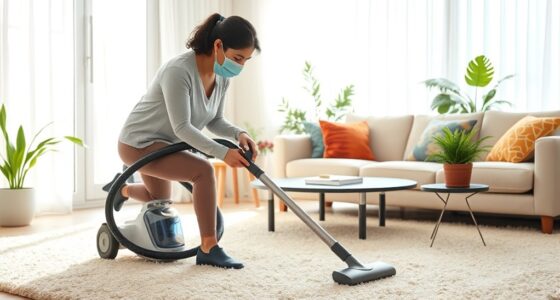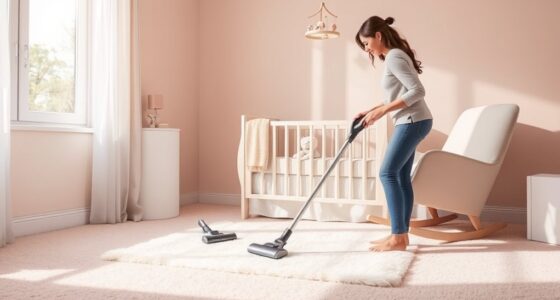To prevent mold and mildew, control your home’s humidity levels between 30-50% by using exhaust fans, dehumidifiers, and opening windows when possible. Regularly inspect areas prone to moisture, like bathrooms and kitchens, and promptly fix leaks or poor ventilation issues. Keep airflow steady with fans and air purifiers, and clean or repair vents as needed. Maintaining these habits helps create a healthier indoor environment—continue to explore more smart tips to keep moisture at bay.
Key Takeaways
- Use exhaust fans in bathrooms and kitchens during and after activities to remove excess moisture effectively.
- Maintain indoor humidity levels between 30-50% with a hygrometer to prevent mold growth.
- Increase ventilation by opening windows and using fans to improve air circulation and reduce moisture buildup.
- Regularly inspect and clean ventilation systems and use dehumidifiers in damp areas to control excess humidity.
- Address signs of mold or musty odors promptly through cleaning and fixing humidity sources to prevent mold proliferation.

Controlling household humidity is essential for maintaining a comfortable and healthy living environment. When humidity levels are too high, it creates the perfect conditions for mold and mildew to thrive, which can damage your home and affect your health. One of the most effective ways to regulate moisture is by improving your home’s air quality. Clean, fresh air helps keep humidity in check and reduces the risk of mold growth. Proper ventilation systems play a vital role in this process, ensuring that excess moisture doesn’t linger indoors.
Controlling indoor humidity prevents mold and promotes a healthier, more comfortable home environment.
If you notice a musty odor or visible signs of mold, it’s a clear sign that your indoor air quality isn’t ideal. Ventilation systems, such as exhaust fans in bathrooms and kitchens, help remove humid air directly from these moisture-prone areas. Installing or upgrading these systems allows you to control humidity levels more efficiently. For example, using exhaust fans during and after showers or cooking prevents steam from accumulating and settling on walls or ceilings. Additionally, keeping windows open when weather permits can improve air circulation, further reducing indoor moisture.
Another way to maintain optimal air quality is by using air purifiers equipped with HEPA filters. These devices can trap mold spores and other airborne pollutants, helping to keep your indoor environment healthier. However, they work best when your ventilation system is functioning properly, as they complement the airflow and moisture control rather than replace it. Regularly inspecting and maintaining your ventilation systems ensures they operate effectively and prevent moisture buildup. Dirty or malfunctioning exhaust fans and vents can become sources of excess humidity if not cleaned or repaired promptly.
Controlling humidity isn’t just about installing the right systems; it also involves paying attention to daily habits. Running exhaust fans during cooking and showering, drying clothes outdoors when possible, and using dehumidifiers in damp areas can substantially reduce indoor moisture. Keep an eye on humidity levels with a hygrometer, aiming to keep them between 30% and 50%. When humidity creeps above this range, it becomes easier for mold spores to settle and grow. Incorporating proper air circulation practices, such as using fans or opening windows, further enhances moisture removal and promotes a healthier indoor environment.
Frequently Asked Questions
How Does Indoor Humidity Affect Allergy Symptoms?
You may notice allergy symptoms worsen when indoor humidity is high because it encourages mold growth and traps airborne allergens like dust mites and pet dander. Excess moisture creates a perfect environment for mold, which releases spores that can irritate your airways. Keeping humidity levels between 30-50% helps reduce mold growth and airborne allergens, easing allergy symptoms and improving indoor air quality.
Can Houseplants Help Regulate Indoor Humidity Levels?
While houseplants can gently influence plant moisture and support humidity balance, they shouldn’t be solely relied upon to control indoor humidity levels. Your plants add a touch of natural charm and can increase moisture slightly, but for significant regulation, you’ll want to use a dehumidifier or proper ventilation. Think of plants as a subtle, natural complement rather than the main solution for managing humidity and preventing mold growth.
What Are the Best Dehumidifiers for Small Spaces?
You should consider portable units with compact designs for small spaces. Look for dehumidifiers that are lightweight and easy to move, so they fit comfortably in tight areas like bedrooms or closets. Brands like Frigidaire, Eva-dry, and hOmeLabs offer reliable options. These units efficiently reduce humidity, prevent mold, and are energy-efficient. Choose one with adjustable settings and a removable water tank for convenience, ensuring your space stays comfortable and mold-free.
How Often Should I Check My Home’s Humidity Levels?
You should check your home’s humidity levels weekly, like keeping a finger on the pulse of your space. Use humidity sensors or moisture meters to get accurate readings, especially in areas prone to dampness. Regular checks help you catch any fluctuations early, preventing mold and mildew. Maintaining ideal humidity (between 30-50%) keeps your home comfortable and dry, so make it a routine to monitor and adjust as needed.
Are There Natural Methods to Reduce Household Humidity?
Yes, you can naturally reduce household humidity by using ventilation strategies like opening windows and using exhaust fans to increase airflow. Additionally, place moisture absorbers such as charcoal briquettes or silica gel packets in damp areas to help absorb excess moisture. These methods work together to lower humidity levels, preventing mold and mildew growth without relying on chemical dehumidifiers, making your home healthier and more comfortable.
Conclusion
By managing your home’s humidity levels, you can effectively prevent mold and mildew growth. Some believe that keeping indoor humidity below 60% halts mold development, but recent studies suggest mold spores can still thrive at lower levels, especially in damp environments. So, while maintaining proper humidity helps, don’t forget to fix leaks and improve ventilation. Combining these steps gives you the best chance to keep your home healthy and mold-free.









